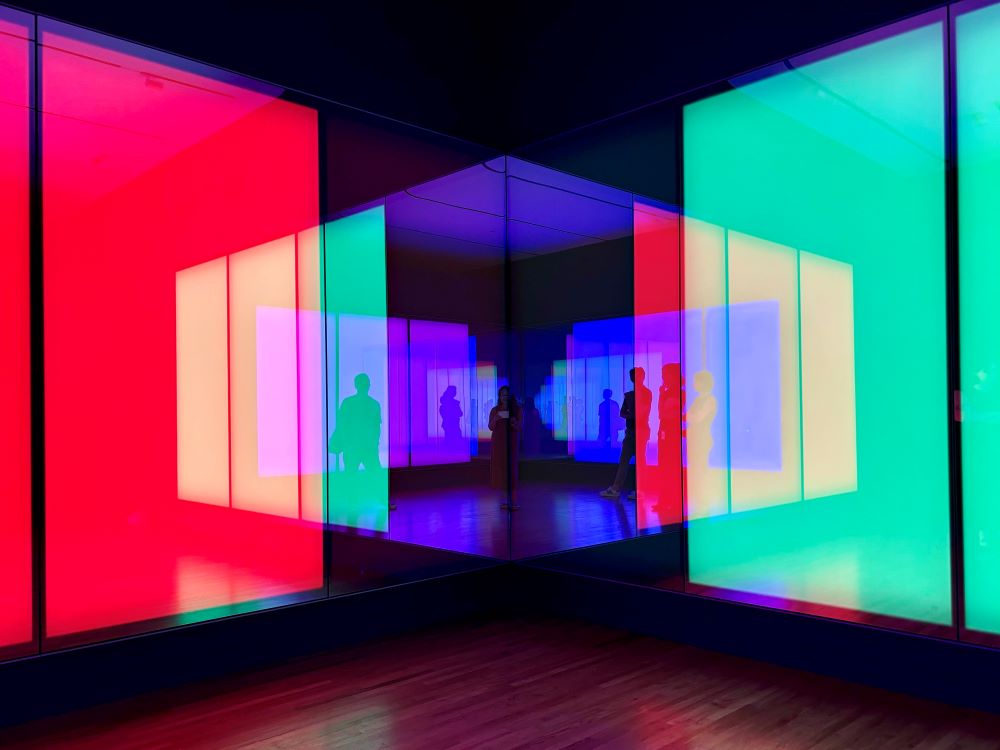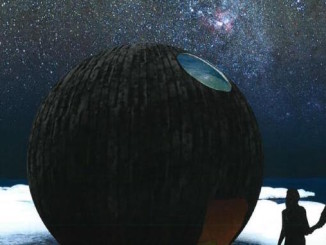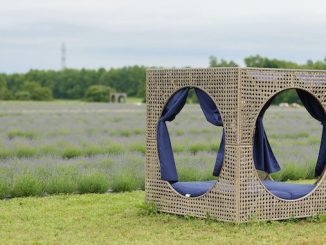Light, in a literal sense, is associated with helping us to see what is all around us. But there’s more to light than what meets the eye. In many cultures, also represents knowledge, guidance and spirituality. The latest exhibition, LIGHT: Visionary Perspectives, at the Aga Khan Museum in Toronto encourages visitors to not only see how artists interpret light in their work but we are also invited to feel the light by fully immersing themselves in the beauty and meaning beyond what initially draws the eye in.
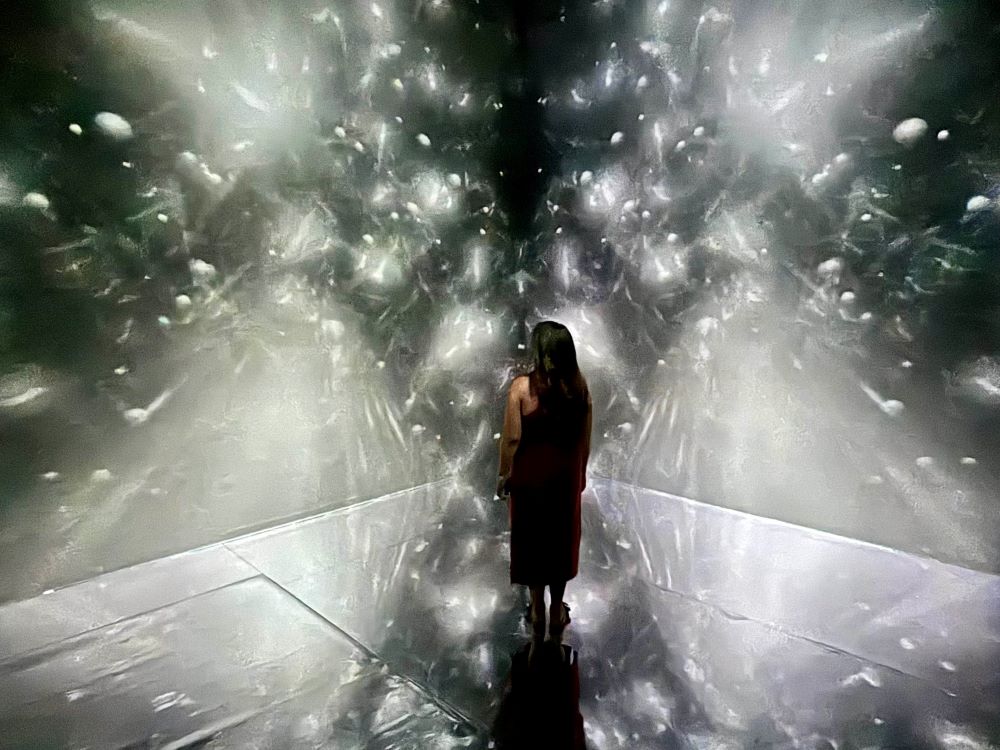
The installations and historical works explore all realms of light — the light of eye, mind, and heart. Initially conceived with the Aga Khan Museum’s 10th year anniversary celebration in mind this year, the works illustrate various physical properties and symbolisms of light. It also showcases light’s universal ability to unite individuals, inspire empathy, and highlight the significance of diversity.
The Aga Khan Museum itself was actually built around the notion of light. Marianne Fenton, Co-curator of this exhibition and Special Projects Curator for the Museum, mentioned His Highness the Aga Khan’s vision statement of “Light” was an inspiration for the Museum. Architect Fumihiko Maki (Maki and Associates), took the concept and viewed the Museum to be considered a beacon or lighthouse in the centre of the city. He envisioned the Museum to be a place that celebrated light and interactions between humans and our surroundings. Surface materials used are a beautiful example of how light shapes the use of space and our perception at any given time of day. Anyone is welcome to come and discover a connection and shared knowledge regardless of where in the world they came from.
There are 11 stunning installations to explore within the LIGHT: Visionary Perspectives exhibition. Artists included Canadians as well as those who are internationally known. They represent a diverse range of cultures. They are emerging as well as world-renowned. Artists include Kimsooja, Tannis Nielsen, Anish Kapoor, Jamelie Hassan, Ala Ebtekar, Sanaz Mazinani, Mallory Lowe Mpoka, Olafur Eliasson, Ghazaleh Avarzamani, and Phillip K. Smith III.
There is an interplay between the installations but they hold multiple meanings and convey different messages. They also highlight the importance of language in art often use contemporary materials to break down barriers and create a sense of connection and to help share our perceptions and how we experience art.
We won’t reveal every part of this exhibition because it truly warrants an in person visit and definitely want some of it to be a surprise. However, we’ll highlight three of the jaw-dropping contemporary installations here and encourage you to spend the time to visit and experience them all.
TO BREATHE by artist Kimsooja (b. Taegu, Korea):
Visit on any given sunny day and you won’t miss the spectacular floor-to-ceiling glass courtyard as the playful sun beams in and transforms the soothing white space with a playful motif. Conceptual artist Kimsooja covers the glass exterior windows with a special clear film that creates a diffraction grating effect throughout the open space. Her work is about bringing our eyes to what is already there. She allows the sunlight to do what sunlight does. When the sun shines on the mashrabiya pattern, it diffracts the light into the colours of a rainbow. Yes, we’ve seen this before in science class and toys but nothing as spectacular as this!
This particular space was also designed by the architect with light and shadow in mind at any time of day. What is also exciting is how this will present itself differently each time someone views it. And with the 10th anniversary, this draws our attention back to the architecture that we may have seen many times over but in a different light.
“There’s this lovely kind of balance and it fills the space. It’s strong and very descriptive. It has a presence without being very invasive,” said Fenton.
She also spoke about bottari, a Korean tradition of wrapping, and carrying, unbreakable objects and gifts. It’s the idea that one’s belongings can be carried beautifully every day. One could view this installation as a form of wrapping by the artist of the space. She’s wrapping the space and creating a kind of safe space while also drawing attention to how the light diffracts into multiple colours. Fenton tells us that’s really a symbol of pluralism. “It’s the idea that we’re all as humanity pretty much the same, but also, we have our differences. There is uniqueness in each of us that is also celebrated yet we are also we are connected.”
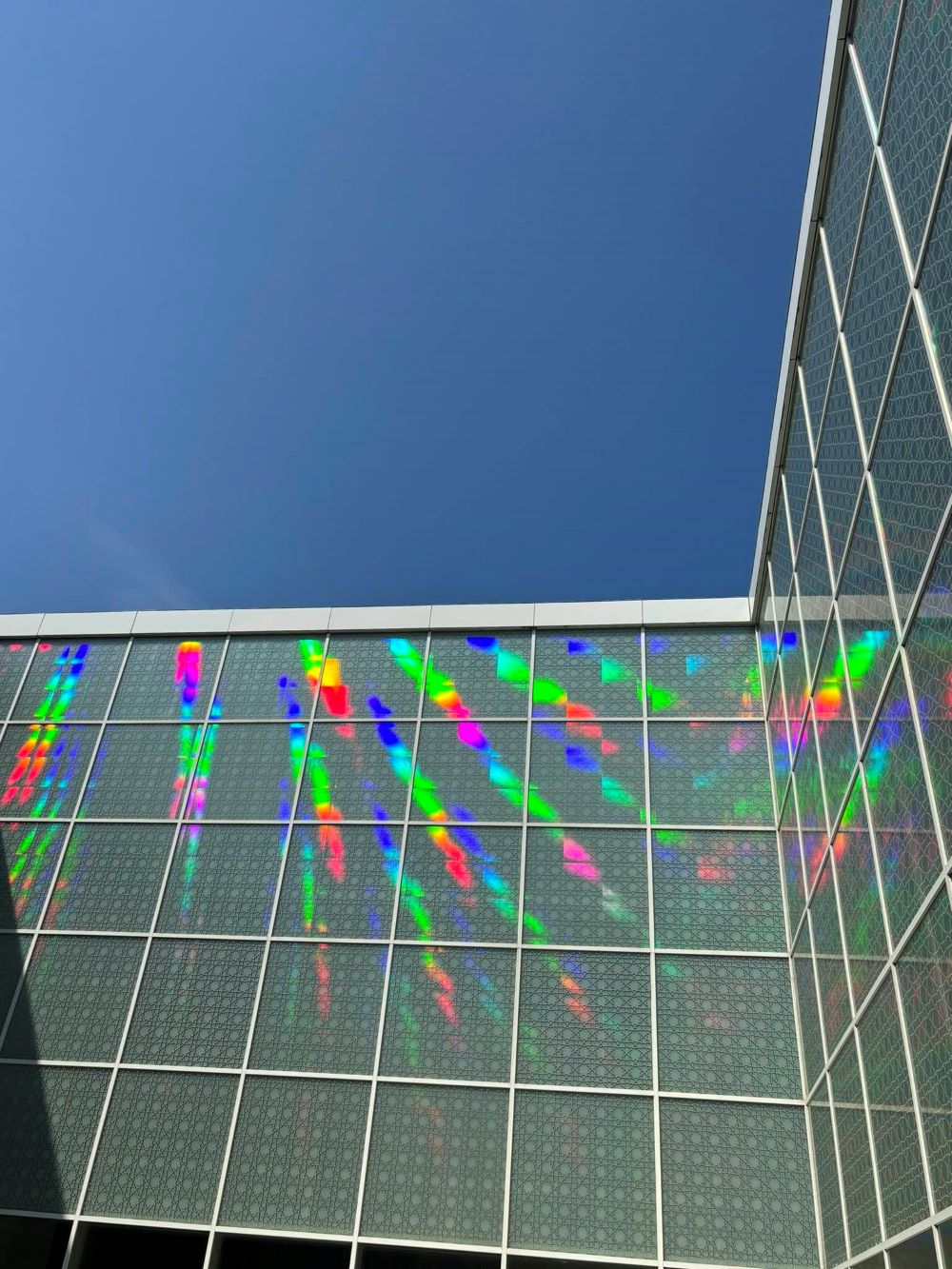
mazinibii’igan / a creation by artist Tannis Nielsen (b. Red Deer, Alberta):
This Anishinaabe-Red River Métis multidisciplenary artist and academic explores Indigenous decolonization methodologies, oral histories, feminism and the relative infestation between Indigenous scientists and quantum physics. This incredible digital video installation narrated by Elder Marie Gaudet, a knowledge keeper and practitioner of healing songs and ceremonies (Turtle Clan Anishinaabe from Wikwemikong), invites visitors to step into this mesmerizing reimagining of Creation from an Indigenous perspective stemming from the Big Bang – believed to be the beginning of the universe.
In one of the Anishinabek creation stories, we learned about Gitchi Manitou (the Great Spirit/Great Mystery) and how he was alone with his thoughts. We learned how the thoughts bursted into moments of light. And with the accumulation of light the universe was created. This installation is about light and darkness being divided and creating life. We also learned when the artist was editing videos, she realized there were flashes of light on the screen that she couldn’t quite understand how the came about. She then started doing research and realize it was electromagnetic energy. So, she capture these moment and multiplied them, playing with them and worked to add more footage. “That was the starting point of this kind of electromagnetic energy that is invisible until it’s made visible.”
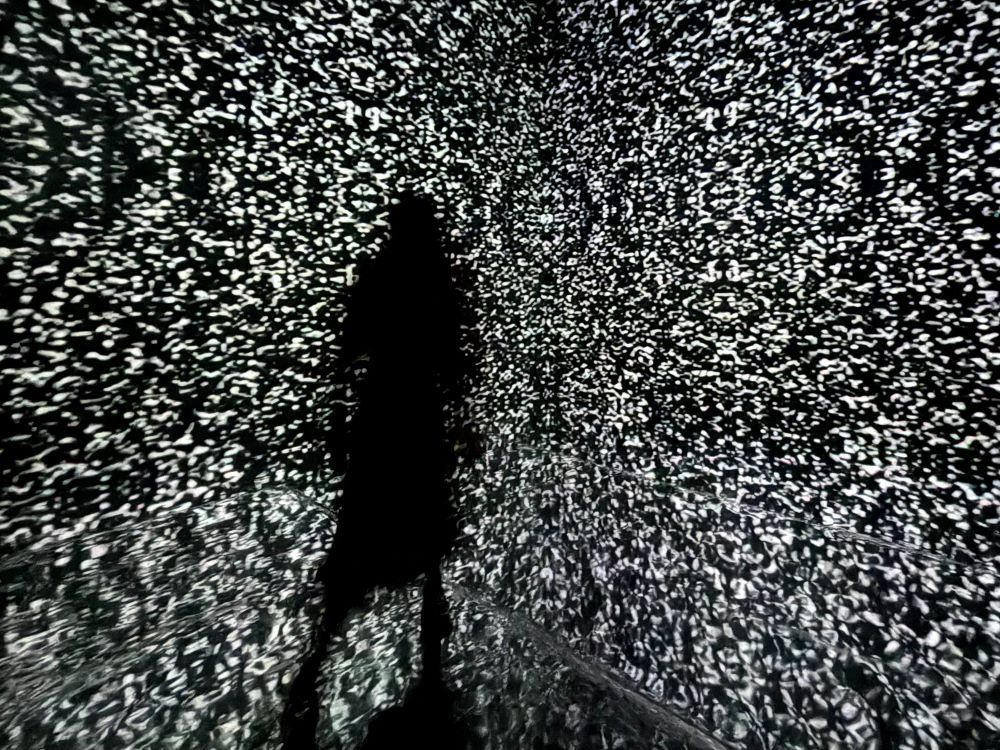
A THOUSAND SILENT MOMENTS (Rain Forest)by artist Anila Quayyum Agha (b. Lahore, Pakistan):
This internationally acclaimed Pakistani-American artist is recognized for her large-scale immersive installations. Her work was included in the Venice Biennale of works exploring light and shadow inspired by Islamic architecture. This is the artist’s first showing in Canada.
In this work commissioned by the Aga Khan Museum, the artist was inspired by objects and paintings found in the Museum’s collections. Elaborate laser-cut patterns of florals, vines, and animals are created in lacquered steel and LED bulbs. Like a rainforest, this installation is a balance of its ecosystems. The motives seamlessly work together as they cast shadows onto throughout the space. It serves as a reminder of how our world is interconnected with nature.
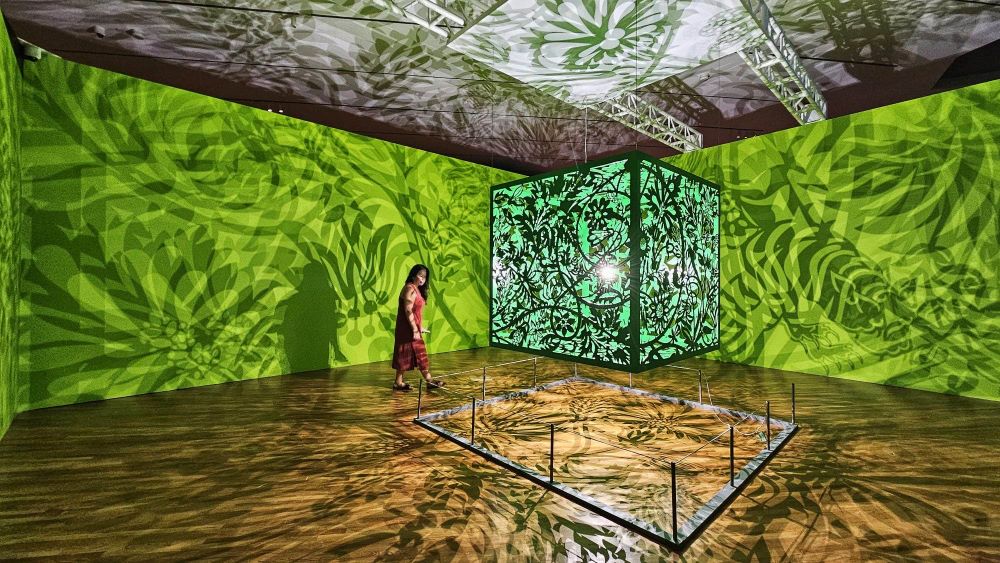
Historical Artifacts:
The exhibition fills the museum on the second level with ample space to experience it all. Be sure to conclude by returning to the main museum space where several artifacts tie in historical aspects mostly through the lens of Islamic and Muslim societies. Items are grouped here are more about light and the notion of life and faith.
“There is a chapter in the Quran known as the ‘light’ chapter, and there’s a particular verse called the ‘light verse.’ That has been a source of inspiration over centuries, including to this day for artists,” said Bita Pourvash, co-curator of the exhibition and the Aga Khan Museum’s Associate Curator.
Also featured, is one of the earliest devices that is used to tell time, and to guide where you are going. These devices made of metal harnessed the light of stars and the sun to guide to locations, time and space.
Another interesting artifact in a manuscript on loan from McGill University. A Latin translation of the Book of Optics by Iraqi scholar Ibn al-Haytham (Alhazen) in the 16th century (original written 1011 to 1021). He studied the structure of the eye and how our lens of the eye works. Prior to his theory, scientist believe that we see because light comes out of our eye. He was the one who turned that theory the other way around. Often referred to as the father of modern optics, this mathematician, physicist, and astronomer made significant contributions this was his most significant and influential work.
LIGHT: Visionary Perspectives is now open until March 17, 2025, at the Aga Khan Museum. The exhibition is great for multigenerational visitors. There are also a few activations for kids to get hands on to explore the theme further. For hours and admission details visit www.agakhanmuseum.org
